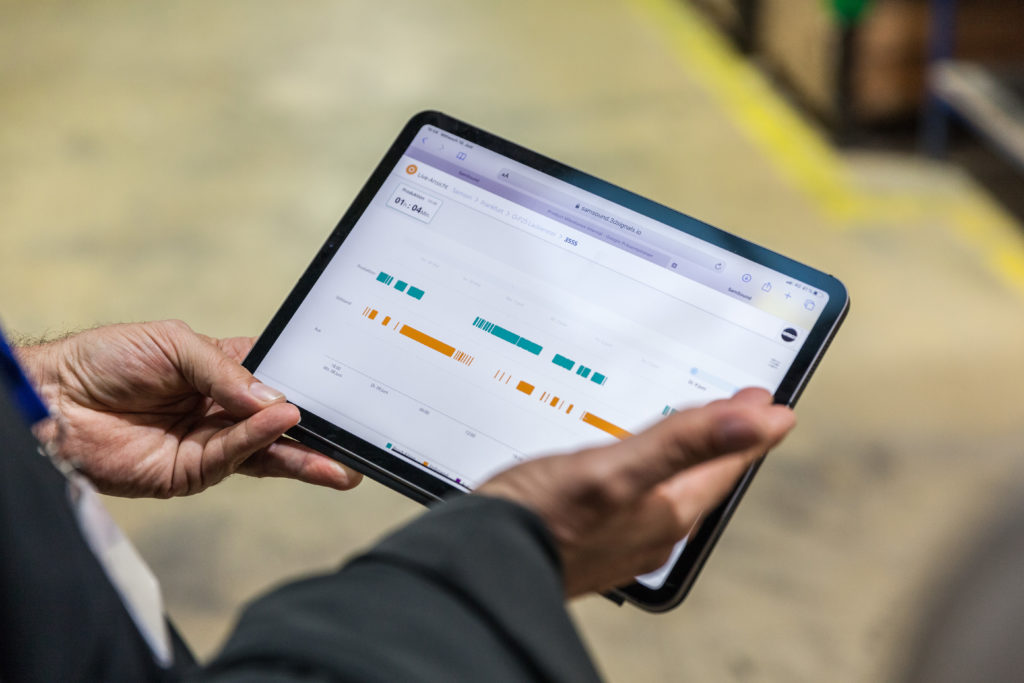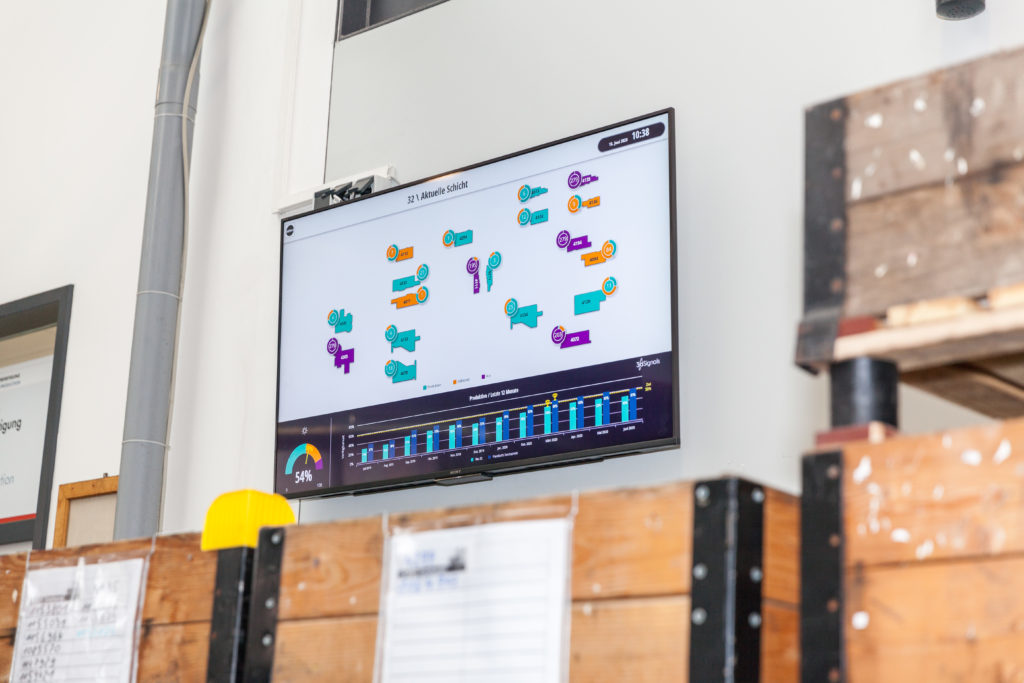
In our modern, competitive economy, production managers and supervisors must be able to keep up with machine performance and efficiency. However, it is practically impossible for production managers to accomplish this on their own, without the right tools. Tracking machine efficiency in a large manufacturing plant is time-consuming, inaccurate and delayed, when performed manually.
To accomplish this in real-time based on manual reporting, a company would have to hire a dedicated person or even a team whose primary responsibility is to measure overall equipment effectiveness (OEE) and prevent machine downtime. Even then, there will always be lags in reporting followed by delayed response to inefficiencies, machine faults, and downtimes.
The solution, as in many cases in our modern world is digital Asset Performance Monitoring, which provides data in a digital and real time format. Automatic asset performance management utilizes innovative technologies such as the Industrial Internet of Things (IIoT) to generate real-time data from machines, production floors and entire factories in order to enable visualization and analysis that can promote efficiency and productivity improvements.
But why is production monitoring so important? What makes keeping track of the efficiency on the floor so critical?
There are three main reasons for this.
The primary benefit of production monitoring is that it ensures that all machines are operating at maximum capacity at all times. This has a direct impact on productivity.
Every minute that a critical piece of machinery is sitting idle when it’s supposed to be manufacturing and producing products is affecting the top line.

The more every machine is functioning at peak efficiency, a company can produce more products in less time. Keeping track of machine idle time and downtime has the potential to identify and resolve inefficiency.
Consider how many times a manager looks at the production numbers per shift and struggles to reconcile lower values on the afternoon shift compared to the morning shift or vice versa but can’t find the solution. In this example, a manager could spend hours on the floor, observing each machine and worker, taking notes, and still not come to the right conclusion. Having a manager or floor supervisor attempting to monitor every aspect of all machine, parts, and components to avoid potential downtimes is unreasonable at best.
Furthermore, production monitoring is complicated enough with just a couple of machines, but when manufacturing encapsulates dozens or even hundreds of machines, it can quickly overwhelm even the most diligent supervisory staff.
Investing in the right Asset Performance Monitoring strategy brings this exact data right onto the computer screen of the supervisors, helping them keep the manufacturing process running smoothly, making sure the factory is maximizing its productivity and, as such, the revenue.
No company wants to experience waste. Especially not those who are environmentally conscious. Yet, there are dozens of ways a company can bleed money.
It can happen through poor energy management, machine downtime, wasted raw materials, scrapped goods, and many more.
By having an effective way of tracking machine efficiency, companies can improve planning and optimize processes in order to better project the quantities of raw materials, labor hours, and energy resources needed. The more accurate the planning and execution are, the less waste will be generated.
The manufacturing process is a complicated one and the larger the company is, the more diverse its portfolio is, the more business units it has, the more complex it becomes. Attempting to keep everything operating as designed, as planned and on time is an overwhelming challenge when done manually or using old-school reporting systems. By implementing real-time production monitoring in combination with BI tools that help extract actionable insights and facilitate data-driven decision making, operating the business becomes easier.
When data is available in real-time and from remote, it is easier for managers to connect the dots. This is the only way to identify bottlenecks and understand which processes and which products are causing delays. By using effective monitoring, it is no longer a matter of trial and error, but rather driving right at the heart of the problem.
For example, one manufacturing company discovered through machine monitoring that a specific machine was down for a significant amount of time every morning, holding back an entire production line. This deficiency had nothing to do with faulty equipment or poorly trained workers, but rather with raw materials not being delivered to the station on time. This meant that the operators had to either wait for the supplies or go gathering them from the warehouse, either way causing an unplanned work stoppage.
When the manager recognized this problem, he was able to cross reference with planning and logistic schedules, change priorities and processes and make sure that raw materials were provided prior to start of the shift. Without recognizing this flaw in the production process, the bottleneck may very well have continued going unnoticed, causing additional waste and reducing productivity.
1. Improve cross-organization processes
Visualization of the manufacturing process from end to end, can help identify bottlenecks. Only when the entire process is monitored inefficiencies can be identified. Optimization can occur at any of the steps separately, or at the intersection of two or more processes, starting at raw material ordering and purchase order processing, continuing with manufacturing and packaging, and ending in warehousing, shipping and customer servicing.
The previous example in which a bottleneck occurred because raw materials were not always on hand, is a clear indication of poor process management. The larger, more complex the manufacturing process becomes, the more likely disorganization can build up over time.
Disorganization usually begins small, and slow. But in time, gaps in the value chain develop, especially in the crossroads with production lines, which are labor intensive and usually not connected or monitored.
Monitoring and analyzing all aspects, lines, stations, and components of the facility provides an opportunity to improve organization and ensure that all staff on site during all shifts are being used to their fullest capabilities, skills, and talents.
2. Be proactive to keep machines operating at peak performance levels
A machine that is not operating for any length of time during a shift is losing revenue. Yet, there are many reasons why machines might not be operating throughout a given shift (or even for multiple shifts).
One possible reason could be due to the setup. If a machine is making more than one part per shift, every time the operator needs to switch to another product, there is a delay caused by machine setup and calibration. Data analysis can reveal those cases in which a machine is idle for long hours due to setup, and improved planning can increase this machine’s productivity.
Another possible reason is operator break times. Productivity could change significantly if employees take staggered breaks and not a simultaneous break of all machines. Decisions regarding the value of either methods can only be taken based on efficiency data.
Even downtime for scheduled maintenance can be better managed when tracked and monitored.
3. Motivate employees
Digitalization and visualization make it easier to set realistic goals and track the progress for meeting them. This will encourage employees to keep improving to meet higher goals every time.
When performance data is transparent and clear, employees can be engaged to make group improvements. Tap into their knowledge and insight. Manufacturing workers don’t like to be labeled snitches, telling about the problems other employees are making, but when engaged in a positive competition to win mutual targets, and when confident in their capabilities, they’ll become more open to helping management keep abreast of every detail. Offering rewards for a boost in performance levels, which is closely tied to the monitored data, can be helpful.

4. Create a more standardized work approach
When you have a solid way to measure machine efficiency, downtime, performance levels, and more, you can create a standardized unit of measurement. This means that from shift to shift, machine to machine, it becomes more efficient to gauge the true nature of performance levels.
By creating a standard method of measurement, you can recreate the same measurements across the entire organization, whether it is small and only operates with one facility and few machines or multiple facilities with hundreds or thousands of machines in distance geographic locations around the world.
The only true way to measure one unit against another, especially when they perform different tasks, is by standardizing the processes. In doing this, it allows businesses to create an overall more standardized work approach.
5. Create a dollar value for every component of the manufacturing process
Machine efficiency tracking is used to understand the actual time, labor, energy and raw materials required to produce a single part. When each parameter is measured and monitored accurately and in real time, it is easier to figure out how to improve the cost of making a single part.
No single employee can have a clear understanding of the cost structure of a given product in terms of raw materials, energy consumption, labor investment, shipping cost, etc. Monitoring and documenting each of these components is the only way to achieve better visibility into this important aspect.
Assigning a dollar value to everything throughout the process may help optimizing the product cost. Even saving a few cents on each step of the value chain can amount to thousands of dollars when talking about products that are sold in the millions.
It could be as small as shutting off the machines when they are not operating rather than keeping them idle and wasting energy. This may amount to only a few dollars a day, but multiply this by 365 days per year, and dozens or hundreds of machines per factory, and the numbers grow exponentially.
6. Improve customer satisfaction
When the entire value chain is digital and transparent, it is easier to do accurate planning, and be more accurate about delivery times, so that customers can be sure they’ll get their order in time and in quality.
It is also easier to react fast to changes in demand and response. If a specific customer has some urgent needs and a specific work order needs to be expedited, only if the entire process is connected and monitored, can this be done in a way that will guarantee fast delivery of this holder, without dramatic delays to all other pending orders.